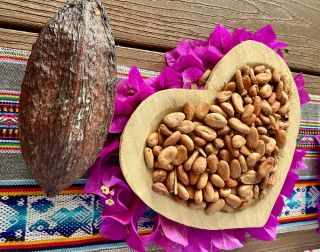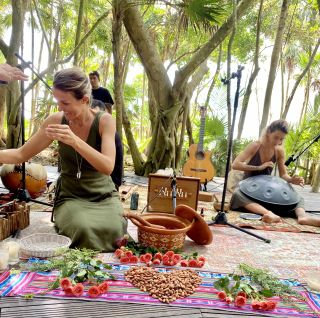Loneliness
The Cacao Craze
Could cacao ceremonies answer the call for connection?
Posted May 31, 2023 Reviewed by Vanessa Lancaster
Key points
- The U.S. Surgeon General recently reported that loneliness is an epidemic.
- There is a call for creative ways to encourage people to find positive and authentic connections.
- Cacao ceremonies invite individuals to taste a healthy, warm, ancient beverage made from the cacao seeds.
- Cacao circles are mindful gatherings that foster open sharing and connection.

Half of all adult Americans reported feeling lonely prior to Covid-19 (Bruce et al., 2019). In May 2023, the U.S. Surgeon General reported that loneliness and feelings of isolation are now at epidemic proportions (see link for full report). Loneliness profoundly affects our physical, societal, and mental health. Those in the psychological professions know It is often at the root of depression, substance use disorders, and suicidal ideation.
Could chocolate offer one answer to this call for connection?
The answer is “yes,” if you have an opportunity to take part in cacao circles.
What is cacao?
Cacao is a fruit believed to originate from trees along two main rivers of the Amazon basin in South America. Once discovered, it expanded north to people in Southern Mexico and North America. It is believed that the Olmecas first cultivated cacao around 2000 BC as a flavored drink, grinding the dried seeds and mixing the powder with water. Later, the Maya, Toltecs, and Aztecs introduced this special seed beverage to their cultures. Believing in its specialness, these ancient societies offered cacao to the Gods in ceremony. Cacao was thought to represent the heart, and the dark drink symbolized the blood of earth. For some, it was served cold, and for others, it was a hot beverage.
The word "chocolate" comes from the Mayan word “chocolhaa,” meaning “bitter water.” The Aztecs called it “xocolatl.” Each group found ingredients to add to the heated mixture to lessen the bitterness and sweeten the final product. Corn, chilies, vanilla, and later, the Spanish added sugar and cinnamon. In ancient times, this luxurious drink was reserved for nobles. Later, cacao beans were bought and sold in community markets and used as a trade currency.
According to legend, an Aztec emperor shared cacao with Spanish conquistador Hernan Cortes. In the early 1500s, Cortes sailed back to Spain with the new, unique beans. The Spaniards grew fond of the special warm elixir and served it at weddings, funerals, harvests, births, coronations, and military victories.
The Spanish brought cacao to Europe in 1518. Its unique flavor and properties moved it through many cultures. Cacao was thought to have medicinal and nutritional benefits, providing strength, energy, and sometimes even prophetic visions. In the 17th century, the Swiss further refined raw cacao by separating the butter and the grounds, and then remixing them with sugar and other ingredients to make "milk chocolate."
The Latin name for the cacao tree is “Theobroma Cacao,” which translates to “Food of the Gods: Cacao.” Theobromine, first discovered in 1841 by Alexander Woskresensky, acts as a stimulant, relaxing blood vessels and muscles while bringing about sensations of well-being. Cacao is similar to other stimulants containing theobromine (i.e., cola nut, mate, guarana) but is not addictive. Cacao is currently considered a "superfood" because of its high amounts of minerals, vitamins, and antioxidants.

What is a cacao ceremony?
As we know them today, Cacao circles began with the new age movement. They are now popular in the world of wellness, especially in Mexico. These reverent, ceremonial circles focus on sharing this ancient heart-opening seed prepared as a warm, delicious, frothy beverage for groups.
As a host of hundreds of cacao ceremonies in Mexico and around the world, Pilar Tarrado reports, “We all know chocolate. If we are sad, we reach for chocolate. If we love someone, we give them chocolate. If we are celebrating someone or something, we often have chocolate.” Chocolate continues to be valued as a healer, friend, and celebratory treat.
When Pilar gave birth to her daughter in Mexico, women brought her a gift of cacao. Her friends made a more bitter beverage for the adults and one for the children with almond milk and sugar. The community drank the cacao together to honor the new baby and mother.
Today, Pilar serves cacao in ceremonial circles following her tutelage with an abuela (grandmother teacher). These gatherings often include singing, chanting, intention setting, and dancing. There always is a sacred honoring of the earth and her gifts.
At resorts in Mexico, cacao circles are well-received, sometimes with over 40-50 guests. The fascination with modern-day cacao circles results from curiosity and, of course, our love of all things chocolate.
Could these gatherings also be gaining popularity because we crave ways to share and connect without calling it “group therapy” or needing a drug (i.e., plant-based medicines) as the reason for a sacred circle?
I would say, "Yes!"
The ceremonies I have participated in feel grounding and yet uplifting. We sit close to the earth in a circle, usually with a center altar adorned with flowers, candles, and other offerings. Sitting on the ground immediately invites closer, less reserved connections. The cacao leader fills each small cup from her large pot. The warm cups are passed around the circle, beginning to the left of the facilitator. Each person is asked to silently breathe well wishes and intentions into the beverage as they pass it around the circle. The drink is not consumed until each person receives their share. Then, all sip in silence.
The process feels meditative and reflective. When in circle, I am struck by the stillness and reverence that the cacao brings. After a time, facilitators invite guests into the circle to share what is on their hearts. Without instruction, everyone listens and honors the speaker. The tone is supportive, sacred, and allowing. I am always surprised by the depth of sharing in these ceremonies and the absence of advice-giving or rescuing. While each circle is unique, there is a slow, mindful pace. The ritual format and the cacao invite honesty, openness, tranquility, and ease.
Personally and professionally, I see these circles' appeal and incredible value. When introduced in a cacao circle, chocolate may offer a new, yet ancient, antidote to loneliness by fostering real relationships and connections without pretense or pressure.
Cheers to cacao!
References
Bruce, L.D., Wu, J.S., Lustig, S.L., Russell, D.W., & Nemecek, D.A. (2019). Loneliness in the Unites States: A 2018 National Panel Survey of Demographic Structure, Cognitive, and Behavioral Characteristics. American Journal of Health Promotion, 33(8):1123-1133
https://www.hhs.gov/sites/default/files/surgeon-general-social-connection-advisory.pdf




